Address
304 North Cardinal St.
Dorchester Center, MA 02124
Work Hours
Monday to Friday: 7AM - 7PM
Weekend: 10AM - 5PM
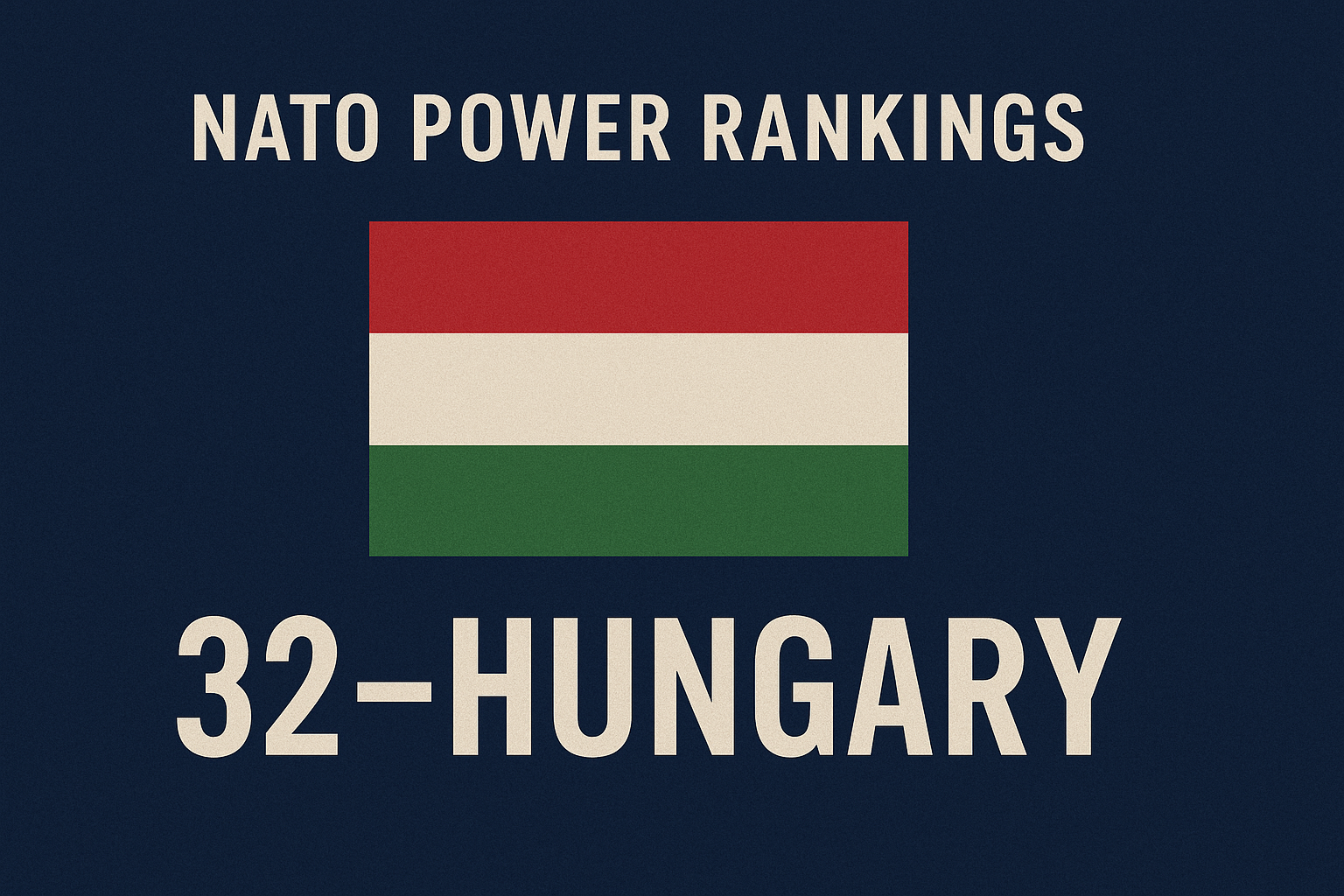
In the 2025 NATO Power Rankings, Hungary ranks dead last — 32 out of 32. This is not a statistical fluke. It is a structural indictment.
N.B. Prime Rogue Inc reached out to the Hungarian military, the Hungarian mission to NATO, the Hungarian Ministry of Defence and the Hungarian Embassy in Canada – none responded to our request for comment.
At a time when NATO faces its most serious strategic threat since the Cold War — a revanchist Russia, a splintering Atlantic consensus, and creeping authoritarianism within its own ranks — Hungary has become the alliance’s weakest link. More than just underperforming militarily, Budapest actively undermines alliance unity, obstructs collective action, and advances the interests of an adversary power: the Russian Federation.
Under the long rule of Prime Minister Viktor Orbán, Hungary has transformed from a post-Soviet aspirant to a competitive authoritarian regime aligned with Moscow on key foreign policy positions. It has refused to send lethal aid to Ukraine, repeatedly blocked EU and NATO decisions, and remains structurally dependent on Russian energy. Its intelligence services are viewed with suspicion. Its government runs narrative operations against NATO consensus. And it has turned its veto into a weapon of diplomatic blackmail — delaying Sweden’s accession to the alliance well into 2024 in tandem with Erdoğan’s Turkey.
Meanwhile, Hungary’s military modernization is skin-deep. Though defense spending has nominally crossed the 2% GDP threshold, its forces remain non-deployable, non-interoperable, and strategically passive. The few Leopard 2A7HU tanks and H145M helicopters it has acquired serve more as political theater than operational enhancement.
This profile dissects Hungary’s failure across four dimensions: Commitment Relative to Size, Defense Readiness, Support for Ukraine, and Consistency and Stability. It concludes with a systemic warning: Hungary is not simply a burden. It is a structural liability inside NATO — a member protected by Article 5, but whose actions daily erode the alliance’s credibility and cohesion.
Hungary’s placement at the bottom of NATO’s 2025 Power Rankings is not due to size alone — it is due to squandered size. For a country of over 9 million people situated on NATO’s southeastern flank, Hungary punches well below its strategic weight. While the Orbán government boasts that it now meets NATO’s 2% defense spending guideline — clocking in at approximately 2.13% of GDP in 2023 — this achievement is deeply misleading. The Hungarian military remains a paper force: minimally deployable, politically stage-managed, and structurally inert.
At the center of Hungary’s military narrative is the Zrínyi 2026 modernization program — a decade-long initiative aimed at revitalizing the Hungarian Defence Forces (HDF). On paper, Zrínyi 2026 includes big-ticket acquisitions:
Yet these systems, many sourced from Germany and the U.S., are operationally siloed, poorly integrated into NATO doctrine, and lacking sufficient trained personnel. NATO observers have privately described Hungary’s procurement strategy as “military cosplay” — visually impressive, but tactically hollow.
Moreover, Zrínyi 2026 suffers from opaque contracting, weak civilian oversight, and an over-concentration of defense policy within Orbán’s political inner circle. The modernization effort has become more about nationalist spectacle than force readiness.
Hungary maintains roughly 29,700 active-duty personnel, according to NATO data — a mid-range force for its size. However, the vast majority of these troops lack high-readiness status. Deployment rotations are limited, NCO development is shallow, and reserve integration is largely symbolic.
While the HDF technically contributes to NATO’s Very High Readiness Joint Task Force (VJTF), its involvement has been limited to logistical and ceremonial roles. Combat-ready formations remain small, under-equipped, and largely untested in live exercises. The ratio of deployable troops to total force size ranks among the worst in NATO.
Hungary’s actual contribution to NATO-led missions is alarmingly low for a member that invokes alliance solidarity when convenient. Consider the following:
By contrast, states of similar size (e.g., Czech Republic, Croatia) contribute far more meaningfully to alliance operations despite facing similar fiscal constraints.
Hungary’s geographic position — bordering Ukraine, Romania, Slovakia, Austria, and Serbia — makes it a potentially critical logistics hub for NATO troop movements and resupply operations should a Russian attack occur via the Suwalki Gap. Instead, Hungary has refused to allow lethal military aid to transit its territory to Ukraine, even as other regional states opened their borders to facilitate war logistics.
This self-imposed exclusion not only weakens NATO’s operational depth, it emboldens adversarial actors by signaling disunity on the alliance’s eastern edge. Hungary has abandoned its geostrategic responsibilities in favor of political neutrality that aligns more closely with Russia than Brussels.
In sum, Hungary may pay its dues, but it does not pull its weight. Despite defense spending that meets alliance benchmarks, the results are illusory. The force remains undertrained, under-deployed, and politically insulated. Hungary is the rare NATO state where form exceeds function, where tanks are paraded more often than deployed, and where contributions are made only when the political optics demand it.
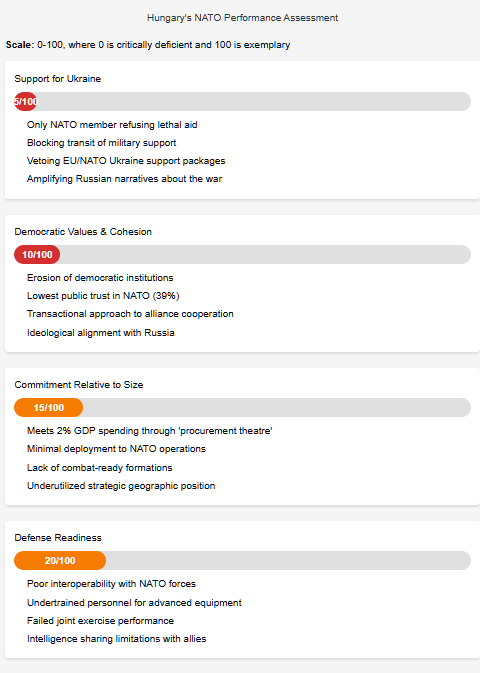
If NATO were tested tomorrow — if Article 5 were invoked not in theory but in blood — Hungary would be a net liability. Despite the glossy procurement headlines and budget increases under the Zrínyi 2026 modernization plan, the Hungarian Defence Forces (HDF) remain tactically brittle, logistically underprepared, and operationally decoupled from the alliance they are sworn to support.
Hungary’s arsenal now includes some of Europe’s most advanced land warfare systems — notably the Leopard 2A7HU main battle tank, the PzH 2000 self-propelled howitzer, and the H145M multi-role helicopter. These assets are NATO-standard in name — but not in function.
Reports from NATO joint exercises suggest:
This is the core issue: Hungary’s modernization is a procurement story, not a doctrinal one. Acquiring high-tech equipment without building the ecosystem of doctrine, command structure, training, and maintenance is the military equivalent of installing a jet engine on a tractor.
While Hungary nominally aligns itself with NATO systems and protocols, its forces consistently underperform in interoperability exercises. Communications infrastructure is uneven, battlefield digitization is primitive, and shared command protocols are often ad hoc or absent.
The 2024 “Black Lancer” joint exercise exposed critical breakdowns:
The failure here is systemic, not incidental. Hungary’s military has not been built to fight alongside NATO forces — only to appear compatible for photo ops and procurement announcements.
Despite surpassing the 2% defense spending benchmark, Hungary ranks near the bottom of NATO in terms of:
The HDF lacks the ability to rapidly reinforce NATO’s eastern front — the critical requirement in the event of a Russian incursion into the Baltics or Black Sea region. In effect, Hungary is a black hole in the alliance’s response grid: large enough to matter, unreliable enough to collapse under pressure.
Additionally, Hungary’s domestic civil-military integration is minimal. There is no equivalent to Poland’s Territorial Defense Force, Finland’s civilian mobilization architecture, or even Romania’s Reserve restructuring. If NATO were to rely on Hungary in a protracted war, the support base — in both matériel and public morale — simply isn’t there.
Perhaps most alarming is the growing quiet among NATO intelligence officers around Hungary’s internal security ecosystem. The Constitution Protection Office (AH) has drawn scrutiny for:
As a result, multiple NATO members — including the Baltic states and the Nordic bloc — have scaled back intelligence sharing with Hungary. While not formally blacklisted, Hungary is functionally air-gapped from the most sensitive NATO intelligence flows.
This is not just a trust issue. It’s a security breach in slow motion.
Summary: Hungary may own NATO-compatible weapons, but it cannot field NATO-ready forces. From logistics to doctrine to intel integrity, the Hungarian defense posture is a Potemkin construct — and NATO knows it. The alliance may extend its shield to Hungary under Article 5, but if that shield ever had to swing back, it would likely find Budapest unarmed, unready, and unreconciled.
In a time of war on NATO’s doorstep, Hungary has chosen obstruction over solidarity. While every other member state has contributed military, financial, or humanitarian aid to Ukraine following Russia’s full-scale invasion, Hungary remains the lone formal opt-out — a rogue node within the alliance’s collective war posture.
This is not passive neutrality. This is strategic subversion.
Since 2022, Prime Minister Viktor Orbán has publicly and repeatedly refused to send any lethal aid to Ukraine — not even through transit corridors. In 2023, Hungary codified this refusal by banning the use of its territory for NATO weapons shipments bound for Kyiv.
Orbán’s rationale? Protection of ethnic Hungarians in Ukraine’s Zakarpattia Oblast, where some 150,000 live. This framing echoes, almost verbatim, the Kremlin’s irredentist logic used in the Donbas and Crimea — ethnic grievance as pretext for geopolitical obstruction.
SEO-rich takeaway: Hungary’s position is unique — it is the only NATO state explicitly opposing lethal aid to Ukraine on ethnic grounds, effectively creating a strategic corridor gap on NATO’s eastern flank.
Hungary’s influence goes beyond passive obstruction. It has wielded its EU and NATO veto powers to:
Hungary even threatened to withhold ratification of Sweden’s NATO accession unless Stockholm capitulated to its domestic grievances — notably around criticisms of Hungarian rule-of-law erosion.
This formed the now-infamous “Turkish-Hungarian Axis of Delay” in 2023–24, which held up Sweden’s NATO bid for nearly 18 months, despite escalating Russian aggression.
In doing so, Hungary has turned NATO consensus into a bargaining chip, not a binding principle.
Hungary is one of only two EU countries still importing significant volumes of Russian gas via pipeline (TurkStream), and it continues to deepen energy ties through:
This isn’t energy realism — it’s energy clientelism. And it comes at a price.
Hungary’s energy posture aligns with Russia’s attempt to fragment NATO’s energy security architecture and exploit internal divisions. Even as Finland and the Baltics harden their grids, Hungary doubles down on Russian flow.
Orbán’s government has not merely abstained from military support. It has attacked the very premise of NATO solidarity in Ukraine. Hungarian state media routinely:
The information terrain inside Hungary has become a pro-Russian echo chamber, where public support for Ukraine has steadily eroded under state propaganda. In NATO terms, this is not neutrality — it is internal cognitive sabotage.
Hungary’s refusal to act in defense of Ukraine has operational consequences:
No other NATO country requires this level of political babysitting in wartime.
Summary: Hungary’s stance on Ukraine is not just diplomatically unhelpful — it is strategically corrosive. It undermines the alliance’s deterrent credibility, fractures public unity, and emboldens adversaries. As NATO reorients toward long-term confrontation with Moscow, Budapest remains a Trojan Horse — not just inside the tent, but holding the door open for Russia.
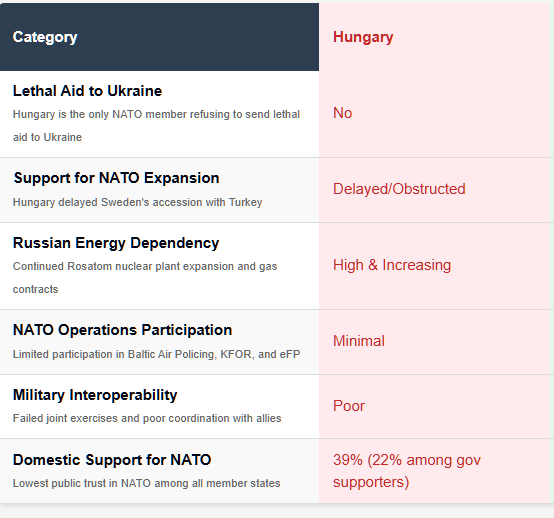
Hungary is no longer a democracy in the classical liberal sense. It is a competitive authoritarian regime operating within a security alliance founded on democratic values. This presents NATO with an unresolved contradiction: how to function as a mutual defense pact when one of its members systematically dismantles the democratic infrastructure it is pledged to protect.
Since 2010, Viktor Orbán has constructed an illiberal political system rooted in constitutional manipulation, media capture, judicial subordination, and cultural grievance. While elections still occur, they do not produce meaningful alternation of power. The Venice Commission, European Commission, and OSCE election monitors have all documented the collapse of democratic safeguards.
In foreign policy circles, Hungary has become the case study for democratic backsliding inside Western alliances. While Turkey’s authoritarian pivot has long been visible, Hungary’s regression is unique because it:
Orbán has proudly declared his intention to build an “illiberal state”, drawing inspiration from China, Russia, and Singapore — and doing so from within the democratic West.
NATO’s preamble affirms its foundation in “democracy, individual liberty, and the rule of law.” Hungary now openly violates all three.
This erosion creates a trust asymmetry: Hungary remains protected under Article 5 — the collective defense clause — but there is growing uncertainty about whether Hungary would honor that clause if, say, Lithuania or Finland were attacked.
This “Article 5 trust gap” is no small matter. It weakens deterrence because it complicates escalation planning. Can Hungary be counted on to deploy troops? Share intelligence? Uphold sanctions? Or will it side with its ideological patrons in Moscow and Belgrade?
Hungary doesn’t just fail at home — it infects abroad.
Orbán has built transnational links with far-right populist movements in:
Through Fidesz-funded think tanks, media partnerships, and political convenings, Orbán positions Hungary as the ideological vanguard of post-liberal Europe. In so doing, he helps destabilize NATO from within by emboldening factions that favor transactional sovereignty, nationalist withdrawal, and accommodation with authoritarian powers.
This is a form of soft narrative warfare that saps NATO of its foundational coherence.
Inside Hungary, state media (largely controlled by the KESMA foundation, a pro-government media conglomerate) floods the airwaves with anti-NATO rhetoric:
This domestic messaging warps public perception, creating a population increasingly resistant to NATO mobilization, alliance funding, or even joint training exercises.
Polls in 2024 showed public trust in NATO among Hungarians dropping to 39% — the lowest in the alliance. Among Fidesz supporters, it was just 22%.
Summary: Hungary is no longer a democracy in NATO’s image — and it’s exporting that divergence. Its political model corrodes the alliance from within by breaking the trust required for collective action. NATO was never designed to contain internal adversaries — and in Hungary, it may have one.
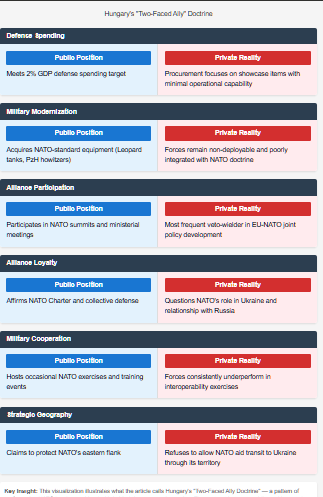
In public, Hungary affirms the NATO Charter. In private, it obstructs it.
This is the Two-Faced Ally Doctrine: a pattern of performative loyalty designed to maintain the material benefits of alliance membership (defense guarantees, EU funding, procurement deals), while simultaneously undermining alliance cohesion to pursue domestic ideological objectives and foreign alignments.
Hungary does not seek to leave NATO. It seeks to reshape it.
Hungary plays the part of a loyal ally — hosting NATO training events, attending summits, and showcasing new weapons systems. But behind the curtain, it has become:
This is not deviation — it is doctrine. Orbán’s strategy relies on exploiting NATO and EU consensus mechanisms to extract concessions far beyond Hungary’s size or contribution.
Hungary’s behavior increasingly resembles institutional blackmail. The state has used its veto or delay power to:
This pattern mirrors hostage diplomacy, but turned inward — not against adversaries, but against partners. It signals to other illiberal regimes that alliances can be gamed without formal exit.
The danger of Hungary lies not in open defection, but in the illusion of compliance. Unlike Russia, China, or even Erdoğan’s Turkey at its worst, Hungary continues to operate within procedural norms — attending summits, filing motions, smiling for cameras.
But this is the camouflage of internal sabotage. Hungary erodes NATO’s internal signaling, decision-making speed, and moral clarity — the very arteries of its deterrence posture.
Summary: Hungary has mastered the art of being inside the alliance but against it. Through vetoes, delays, and transactional obstruction, it turns NATO’s own rules against itself. This is not merely a burden — it is a strategy of decay from within the system.
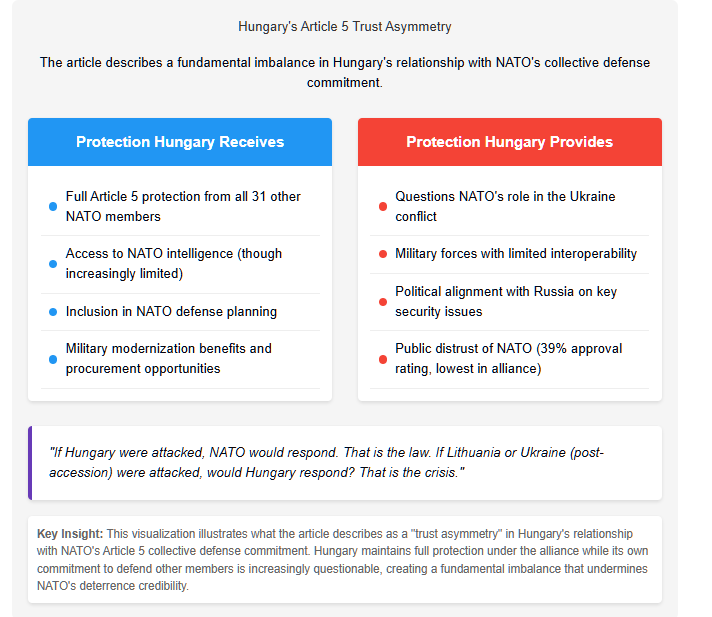
Hungary is not the weakest NATO member because it spends too little or fields too few troops. It is the weakest because it actively undermines what NATO is.
The 2025 NATO Power Rankings place Hungary in dead last — 32nd out of 32 — not due to capacity alone, but because of strategic intent misaligned with alliance survival. What makes Hungary different from other underperformers is not what it lacks, but what it exploits.
Hungary exploits:
It is a structural breach point — a failure not just of capability, but of purpose.
If Hungary were attacked, NATO would respond. That is the law.
If Lithuania or Ukraine (post-accession) were attacked, would Hungary respond? That is the crisis.
Orbán has refused lethal aid, blocked Sweden’s membership, and publicly questioned NATO’s role in the Ukraine war. This creates a trust asymmetry — Hungary receives the shield of collective defense, but cannot be relied on to lift it for others. This imbalance undermines deterrence and invites miscalculation by adversaries.
NATO has no mechanism for expelling members. It was never designed to accommodate internal defection-by-stealth. The assumption — rooted in Cold War urgency — was that all members shared a baseline commitment to Western liberal security. Hungary proves this assumption obsolete.
Orbán’s regime has revealed a blind spot: the inability to defend against allies who act like adversaries inside the decision-making core.
What Hungary exposes is not just a national failing — it’s a system failing. NATO must now confront hard questions:
These are not theoretical questions. They are strategic imperatives.
Final Summary: Hungary is no longer just a laggard. It is a liability embedded in the structure of NATO — a transactional, illiberal actor using alliance mechanics to shield adversary narratives and obstruct collective security. If NATO is to survive the coming decade intact, it must either force Hungary back into alignment — or begin preparing for life with one foot already inside the breach.